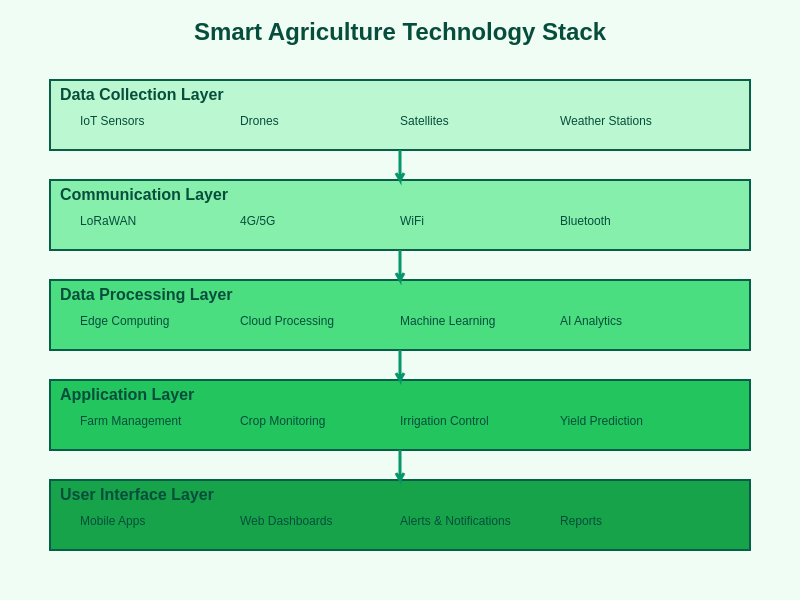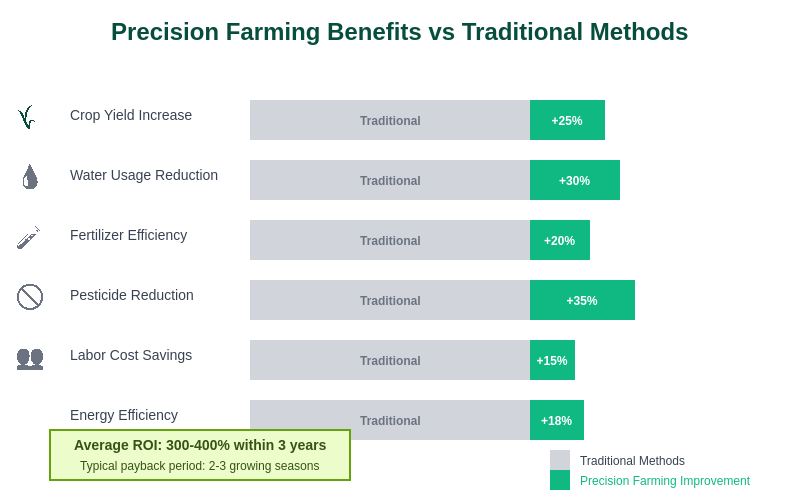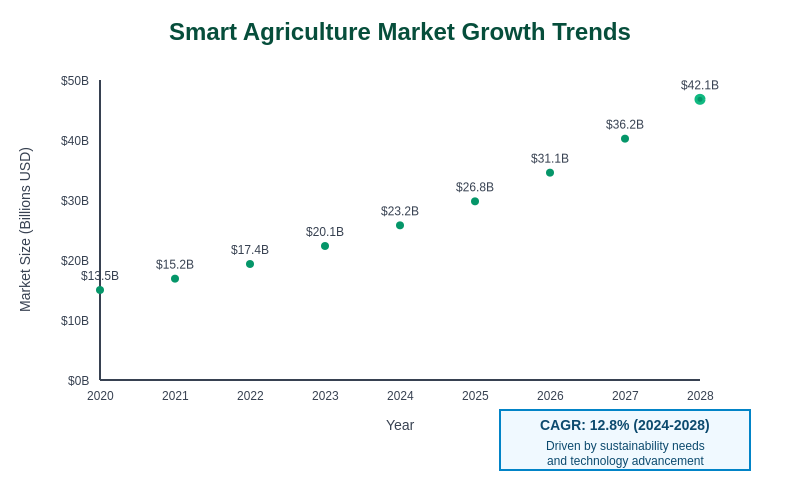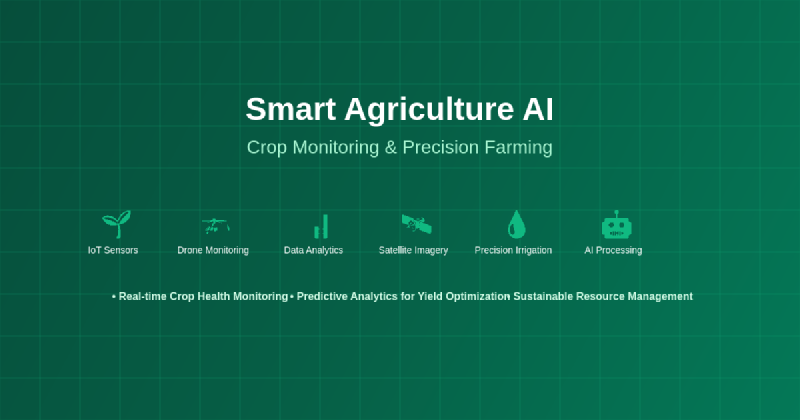The agricultural industry stands at the precipice of a technological revolution that promises to fundamentally transform how we grow, monitor, and harvest crops. Smart agriculture powered by artificial intelligence represents one of the most significant advances in farming technology since the mechanization of agriculture in the early twentieth century. This transformation is not merely about adopting new tools; it represents a comprehensive reimagining of agricultural practices that leverages data science, machine learning, and advanced sensor technologies to create farming systems that are more efficient, sustainable, and productive than ever before.
Explore the latest agricultural AI innovations to understand how cutting-edge technology is reshaping the future of food production and sustainable farming practices. The integration of artificial intelligence into agricultural systems represents a paradigm shift from traditional farming methods toward data-driven decision making that optimizes every aspect of crop production while minimizing environmental impact and resource consumption.
The Foundation of AI-Driven Agriculture
The emergence of smart agriculture represents the convergence of multiple technological advances including Internet of Things sensors, satellite imagery, drone technology, machine learning algorithms, and cloud computing infrastructure. These technologies work in concert to create comprehensive monitoring and management systems that provide farmers with unprecedented insights into crop health, soil conditions, weather patterns, and optimal growing conditions. The foundation of this technological ecosystem rests on the ability to collect, process, and analyze vast amounts of agricultural data in real-time, enabling farmers to make informed decisions that optimize crop yields while minimizing resource waste.
Traditional farming methods relied heavily on experience, intuition, and generalized agricultural practices that were applied uniformly across entire fields or regions. Smart agriculture AI systems challenge this approach by recognizing that agricultural conditions can vary significantly even within individual fields, requiring personalized treatment strategies for different areas based on specific soil conditions, moisture levels, nutrient availability, and microclimatic factors. This precision approach to farming represents a fundamental shift toward individualized crop management that maximizes the potential of every square meter of agricultural land.
Advanced Crop Monitoring Systems
Modern crop monitoring systems utilize a sophisticated array of sensors, imaging technologies, and analytical tools to provide comprehensive insights into plant health, growth patterns, and environmental conditions. These systems combine ground-based sensors that monitor soil moisture, temperature, and nutrient levels with aerial monitoring platforms including drones and satellites that capture high-resolution imagery and multispectral data about crop conditions across large agricultural areas.
The power of AI-driven crop monitoring lies in its ability to detect subtle changes in plant health and growing conditions that would be impossible for human observers to identify until problems become severe enough to cause visible damage. Machine learning algorithms trained on vast datasets of crop imagery can identify early signs of disease, pest infestations, nutrient deficiencies, and water stress by analyzing patterns in plant color, leaf structure, growth rates, and spectral signatures that are invisible to the naked eye.
Enhance your agricultural insights with AI tools like Claude to analyze complex agricultural data and develop comprehensive farming strategies that optimize crop yields while promoting sustainable agricultural practices. The integration of multiple monitoring technologies creates a comprehensive picture of agricultural conditions that enables proactive management strategies rather than reactive responses to problems that have already caused crop damage.

The technological infrastructure supporting precision farming encompasses multiple interconnected systems that work together to optimize agricultural operations. From soil sensors and weather monitoring stations to satellite imagery and machine learning algorithms, each component contributes essential data that enables comprehensive farm management decisions.
Precision Farming Techniques and Implementation
Precision farming represents the practical application of smart agriculture technologies to optimize farming operations at a granular level. This approach involves dividing agricultural fields into management zones based on soil characteristics, topography, drainage patterns, and historical yield data, then applying customized treatment strategies for each zone to maximize productivity while minimizing resource consumption. Precision farming techniques utilize variable rate application systems that can adjust seed planting rates, fertilizer application, pesticide treatments, and irrigation schedules based on the specific needs of different areas within individual fields.
The implementation of precision farming requires sophisticated machinery equipped with GPS guidance systems, variable rate controllers, and real-time sensor feedback mechanisms that enable precise application of agricultural inputs. These systems are controlled by AI algorithms that process data from multiple sources including soil sensors, weather stations, satellite imagery, and historical yield maps to determine optimal treatment strategies for different field zones throughout the growing season.

The quantitative benefits of precision farming technologies demonstrate significant improvements across multiple agricultural performance metrics. These data-driven farming approaches consistently deliver enhanced yields, reduced resource consumption, improved sustainability, and increased profitability compared to traditional farming methods.
Soil Health and Nutrient Management
Soil health represents the foundation of successful agriculture, and AI-powered systems have revolutionized how farmers monitor and manage soil conditions to optimize crop growth. Advanced soil monitoring systems utilize networks of wireless sensors that continuously measure soil moisture, temperature, pH levels, nutrient concentrations, and organic matter content at multiple depths throughout agricultural fields. This real-time monitoring capability enables farmers to understand soil conditions with unprecedented precision and respond quickly to changes that could affect crop performance.
Machine learning algorithms analyze soil data patterns to predict nutrient availability, identify areas prone to erosion or compaction, and recommend optimal timing for soil amendments and cultivation practices. These systems can detect subtle changes in soil chemistry that indicate emerging problems such as nutrient depletion, salt accumulation, or pH imbalances before they significantly impact crop yields. The ability to monitor soil health continuously throughout the growing season enables proactive management strategies that maintain optimal growing conditions while preventing soil degradation.
Water Management and Irrigation Optimization
Water management represents one of the most critical aspects of modern agriculture, particularly as water scarcity becomes an increasingly pressing global concern. Smart irrigation systems powered by artificial intelligence optimize water usage by analyzing data from soil moisture sensors, weather forecasts, crop growth models, and evapotranspiration calculations to determine precise irrigation schedules that meet crop water requirements while minimizing waste. These systems can adjust irrigation timing, duration, and intensity based on real-time conditions and predictive models that anticipate future water needs.
Advanced irrigation management systems utilize machine learning algorithms to identify irrigation patterns that maximize water efficiency while maintaining optimal crop yields. These systems can detect equipment malfunctions, identify areas of over or under-watering, and automatically adjust irrigation schedules based on changing weather conditions and crop development stages. The integration of predictive analytics enables irrigation systems to anticipate water needs several days in advance, allowing for more efficient scheduling of irrigation activities and better coordination with other farm operations.
Discover comprehensive agricultural research capabilities with Perplexity to access detailed information about sustainable farming practices, water conservation techniques, and innovative agricultural technologies that support environmentally responsible farming operations.
Pest and Disease Detection and Management
Traditional pest and disease management in agriculture often relied on scheduled pesticide applications or reactive treatments after problems became visible, leading to overuse of chemicals and potential crop losses from delayed intervention. AI-powered pest and disease detection systems have transformed this approach by enabling early identification of problems through automated analysis of crop imagery, environmental monitoring, and predictive modeling based on weather conditions and pest lifecycle patterns.
Computer vision systems trained on extensive databases of crop diseases and pest damage can identify early symptoms of problems by analyzing high-resolution images captured by drones, ground-based cameras, or mobile devices. These systems can distinguish between different types of diseases, identify specific pest species, and assess the severity of infestations with accuracy that often exceeds human expert identification. The early detection capability enables targeted treatment strategies that use minimal pesticide applications while preventing the spread of problems to healthy crop areas.
Machine learning algorithms analyze patterns in weather data, soil conditions, and historical pest occurrence records to predict periods of high risk for specific pests and diseases. These predictive models enable farmers to implement preventive measures such as beneficial insect releases, targeted pesticide applications, or cultural practices that reduce pest pressure before problems develop. The integration of real-time monitoring with predictive analytics creates comprehensive pest management strategies that protect crop yields while minimizing environmental impact.
Weather Prediction and Climate Adaptation
Weather prediction and climate adaptation represent crucial components of smart agriculture systems that enable farmers to optimize their operations based on current and forecasted weather conditions. Advanced weather monitoring systems combine data from local weather stations, satellite imagery, radar systems, and atmospheric models to provide highly accurate short-term and long-term weather forecasts that inform critical farming decisions such as planting timing, harvest schedules, and protection measures for extreme weather events.
Machine learning algorithms analyze historical weather patterns, current atmospheric conditions, and climate models to predict optimal planting windows, frost risk periods, and seasonal growing conditions. These predictions enable farmers to adjust their crop selection, planting schedules, and management practices to maximize yields while minimizing weather-related risks. Climate adaptation strategies powered by AI analysis help farmers select crop varieties and farming practices that are best suited to changing climate conditions in their specific geographic regions.

The quantitative benefits of precision farming technologies demonstrate significant improvements across multiple agricultural performance metrics. These data-driven farming approaches consistently deliver enhanced yields, reduced resource consumption, improved sustainability, and increased profitability compared to traditional farming methods.
Yield Prediction and Harvest Optimization
Accurate yield prediction represents one of the most valuable applications of AI in agriculture, enabling farmers to make informed decisions about marketing, storage, transportation, and resource allocation before harvest begins. Machine learning models analyze data from multiple sources including satellite imagery, weather records, soil conditions, planting data, and historical yield patterns to generate precise yield forecasts for different areas within individual fields and across entire farming operations.
These prediction systems provide farmers with detailed insights into expected harvest quantities, quality grades, and optimal harvest timing that maximize crop value while minimizing losses from over-ripening or weather damage. Yield prediction models can identify areas within fields that are likely to produce exceptional yields as well as areas that may require additional attention or different management strategies to improve performance in future growing seasons.
Harvest optimization systems use yield predictions combined with real-time crop monitoring data to determine optimal harvest schedules that maximize crop quality and market value. These systems can coordinate multiple harvest operations across large farming enterprises, optimize equipment utilization, and schedule transportation and storage activities to ensure that harvested crops maintain optimal quality throughout the supply chain.
Economic Impact and Return on Investment
The economic transformation brought about by smart agriculture technologies extends far beyond simple yield improvements to encompass comprehensive changes in operational efficiency, resource utilization, and risk management that significantly impact farm profitability. Economic analysis of precision farming implementations consistently demonstrates substantial returns on investment through reduced input costs, improved yields, enhanced crop quality, and decreased operational risks that combine to create compelling business cases for technology adoption.
Cost reduction opportunities in smart agriculture include optimized fertilizer and pesticide applications that reduce chemical inputs while maintaining or improving crop protection, precision irrigation systems that minimize water consumption and energy costs, and automated monitoring systems that reduce labor requirements for routine crop inspection and data collection activities. These operational efficiencies compound over time to generate significant cost savings that often exceed the initial investment in smart agriculture technologies within two to three growing seasons.
Revenue enhancement opportunities include improved crop yields from optimized growing conditions, premium pricing for crops produced using sustainable farming practices, reduced crop losses from early detection and treatment of problems, and improved crop quality that commands higher market prices. The combination of reduced costs and increased revenues creates substantial improvements in farm profitability that justify continued investment in advanced agricultural technologies.
Sustainability and Environmental Benefits
Smart agriculture technologies contribute significantly to environmental sustainability by optimizing resource usage, reducing chemical inputs, minimizing soil erosion, and promoting biodiversity conservation through precision application of farming practices. The environmental benefits of AI-driven agriculture extend beyond individual farm operations to contribute to broader goals of sustainable food production, climate change mitigation, and ecosystem preservation that are essential for long-term agricultural viability.
Resource optimization through precision farming reduces water consumption through efficient irrigation scheduling, minimizes fertilizer runoff through targeted nutrient applications, and decreases pesticide usage through early detection and targeted treatment of pest problems. These reductions in resource consumption directly translate to reduced environmental impact while maintaining or improving agricultural productivity, demonstrating that environmental responsibility and economic viability can be achieved simultaneously through smart agriculture practices.
Carbon footprint reduction represents another significant environmental benefit of smart agriculture technologies. Precision farming practices reduce fuel consumption through optimized field operations, decrease greenhouse gas emissions from reduced fertilizer usage, and promote carbon sequestration through improved soil management practices. Many smart agriculture systems also integrate renewable energy sources such as solar panels to power monitoring equipment and irrigation systems, further reducing the carbon footprint of farming operations.
Challenges and Implementation Considerations
The implementation of smart agriculture technologies presents several challenges that must be addressed to ensure successful adoption and optimal performance. Technical challenges include the complexity of integrating multiple systems and data sources, the need for reliable internet connectivity in rural areas, and the requirement for technical expertise to operate and maintain sophisticated agricultural equipment. These challenges require careful planning, adequate training, and ongoing technical support to ensure that farmers can effectively utilize smart agriculture technologies.
Economic barriers to adoption include the significant upfront investment required for smart agriculture equipment and systems, the need for ongoing subscription costs for data services and software platforms, and the time required to achieve return on investment. Small and medium-sized farming operations may face particular challenges in justifying the costs of smart agriculture technologies, requiring innovative financing options, cooperative purchasing arrangements, or government support programs to facilitate adoption.
Data management and privacy concerns represent emerging challenges as smart agriculture systems generate vast amounts of detailed information about farming operations, crop performance, and business practices. Farmers must carefully consider data ownership rights, privacy protection measures, and data sharing agreements when implementing smart agriculture technologies to ensure that sensitive business information remains secure and under their control.

The rapid expansion of the smart agriculture market reflects growing recognition of the transformative potential of AI-powered farming technologies. Market growth drivers include increasing global food demand, growing emphasis on sustainable farming practices, and advancing technological capabilities that make smart agriculture solutions more accessible and cost-effective.
Future Developments and Emerging Technologies
The future of smart agriculture promises even more sophisticated applications of artificial intelligence and emerging technologies that will further transform agricultural practices and capabilities. Advances in machine learning algorithms, sensor technologies, robotics, and biotechnology will create new opportunities for optimizing agricultural operations and addressing global food security challenges through more efficient and sustainable farming practices.
Autonomous farming systems represent one of the most promising areas of future development, with AI-powered robots and automated machinery capable of performing complex farming tasks such as precision planting, selective harvesting, and targeted pest control without human intervention. These systems will enable farming operations to continue around the clock while reducing labor requirements and improving operational precision beyond what is possible with human-operated equipment.
Integration with biotechnology and genetic engineering will enable smart agriculture systems to optimize crop selection and development based on specific environmental conditions and market requirements. AI algorithms will analyze genetic markers, environmental factors, and performance data to identify optimal crop varieties for specific growing conditions and guide the development of new varieties with improved yield potential, disease resistance, and environmental adaptability.
The continued evolution of smart agriculture technologies will drive further improvements in farming efficiency, sustainability, and productivity while addressing the growing global demand for food production. These advances will require ongoing investment in research and development, infrastructure improvements, and education programs that enable farmers to effectively utilize increasingly sophisticated agricultural technologies.
The transformation of agriculture through artificial intelligence represents one of the most significant technological advances in human history, with the potential to revolutionize food production while promoting environmental sustainability and economic viability. As these technologies continue to evolve and become more accessible, they will play an increasingly important role in ensuring global food security and sustainable agricultural practices for future generations.
Disclaimer
This article is for informational purposes only and does not constitute professional agricultural or investment advice. The views expressed are based on current understanding of smart agriculture technologies and their applications. Readers should conduct their own research and consult with agricultural experts and technology providers when considering implementation of smart agriculture systems. The effectiveness and return on investment of smart agriculture technologies may vary depending on specific farming conditions, crop types, geographic location, and implementation approaches.
